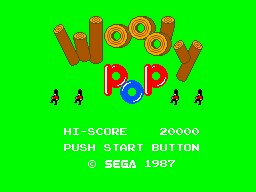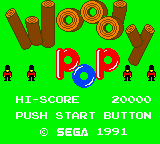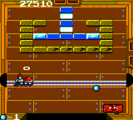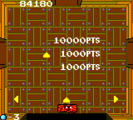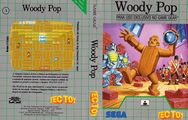Difference between revisions of "Woody Pop"
From Sega Retro
Hyperspeed34 (talk | contribs) |
|||
| (22 intermediate revisions by 9 users not shown) | |||
| Line 1: | Line 1: | ||
| + | {{OtherPage|desc=the version released for mobile phones|page=Woody Pop (mobile)}} | ||
{{Bob | {{Bob | ||
| bobscreen=WoodyPop title.png | | bobscreen=WoodyPop title.png | ||
| − | | publisher=[[Sega]] | + | | bobscreen2=WoodyPop GG Title.png |
| − | | developer=[[Sega R&D 2]] | + | | tab1=Master System |
| + | | tab2=Game Gear | ||
| + | | publisher={{company|[[Sega Enterprises, Ltd.]]|region=JP, EU}}, {{company|[[Sega of America]]|region=US}} | ||
| + | | developer={{company|[[Sega R&D 2]]|system=SMS}}{{company|[[Shimada Kikaku]]{{ref|http://gdri.smspower.org/wiki/index.php/S-Plan}}|system=GG}} | ||
| + | | distributor={{company|[[Tec Toy]]|region=BR}} | ||
| + | {{company|[[Samsung]]|region=KR|system=GG}} | ||
| system=[[Sega Master System]], [[Sega Game Gear]] | | system=[[Sega Master System]], [[Sega Game Gear]] | ||
| sounddriver= | | sounddriver= | ||
| peripherals={{SMS}} [[Paddle Control]] | | peripherals={{SMS}} [[Paddle Control]] | ||
| players=1 | | players=1 | ||
| − | | genre=Action{{ref|https://web.archive.org/web/20181207045745/https://sega.jp/history/hard/gamegear/software.html}}, Puzzle{{fileref|WoodyPop GG EU Box Back.jpg}}{{fileref|WoodyPop GG JP Box Front.jpg}} | + | | genre=Action{{ref|https://web.archive.org/web/20181207045745/https://sega.jp/history/hard/gamegear/software.html}}{{ref|https://web.archive.org/web/20201114213233/https://sega.jp/history/hard/segamark3/software.html}}, Puzzle{{fileref|WoodyPop GG EU Box Back.jpg}}{{fileref|WoodyPop GG JP Box Front.jpg}} |
| releases={{releasesSMS | | releases={{releasesSMS | ||
| − | | | + | | sms_date_jp_c=1987-03-15{{ref|https://web.archive.org/web/20201114213233/https://sega.jp/history/hard/segamark3/software.html}} |
| − | | | + | | sms_rrp_jp_c=5,500 |
| − | | | + | | sms_code_jp_c=C-519 |
}} | }} | ||
{{releasesGG | {{releasesGG | ||
| Line 20: | Line 26: | ||
| gg_rrp_us=29.95{{magref|gamepro|30|132}} | | gg_rrp_us=29.95{{magref|gamepro|30|132}} | ||
| gg_code_us=2203 | | gg_code_us=2203 | ||
| − | | gg_date_eu=1991-11{{magref|segapower|20|20}} | + | | gg_date_eu=1991-11{{magref|ctw|359|21}}{{magref|ctw|361|27}}{{magref|segapower|20|20}} |
| gg_code_eu=2203 | | gg_code_eu=2203 | ||
| − | | gg_date_uk=1991-11{{magref|segapower|20|20}} | + | | gg_date_uk=1991-11-08{{magref|gamesx|29|5}}{{magref|ctw|359|21}}{{magref|ctw|361|27}}{{magref|segapower|20|20}} |
| gg_code_uk=2203 | | gg_code_uk=2203 | ||
| gg_rrp_uk=24.99{{magref|ace|52|94}}<!-- 19.99{{magref|segapower|22|31}}--> | | gg_rrp_uk=24.99{{magref|ace|52|94}}<!-- 19.99{{magref|segapower|22|31}}--> | ||
| Line 31: | Line 37: | ||
}} | }} | ||
}} | }} | ||
| − | + | '''''{{PAGENAME}}''''', known as '''''Woody Pop: Shinjinrui no Block Kuzugi''''' (ウッディポップ 新人類のブロックくずし) in Japan, is a ball-and-paddle game similar to the likes of ''Breakout'' and ''Arkanoid''. It was originally released exclusively in Japan for the [[Sega Master System]] in 1987, before being given an international release on the [[Sega Game Gear]] in 1991. | |
| − | A US Master System release of the game was planned but cancelled{{magref|ce|6.10|13}}. | + | The Master System version of the game is designed to be used with the [[Paddle Control]], and it does not function correctly with any other controller. It would be the last game released in Japan under [[Sega Card|Sega My Card Mark III]] storage media. A US Master System release of the game was planned but cancelled{{magref|ce|6.10|13}}. |
| + | |||
| + | ==Story== | ||
| + | In the Japanese version, Woody (ウッディ) is a tree spirit who must venture into the Bizarre Building (ビザール館) to rescue gumballs, destroying the building blocks in the way. | ||
| + | |||
| + | In the Western versions, the Enchanted Mansion is a toy factory that produces magical toys. The Mad Machine, a crazed gumball machine, has taken over the factory and blocked off its rooms. Woody Pop is a wooden toy who must break down the block barriers and free the factory. | ||
| + | |||
| + | ==Gameplay== | ||
| + | {{ScreenThumb|Woody Pop GG, Gameplay.png|width=160|Gameplay}} | ||
| + | {{ScreenThumb|Woody Pop GG, Branching Paths.png|width=160|Branching paths}} | ||
| + | Players control Woody, a wooden paddle that must bounce a ball in rooms filled with blocks. Blocks consist of normal blocks, which disappear when they are hit by the ball, special "mystery" blocks that release hazards such as toy soldiers and wind-up robots, and crystal blocks that release items that grant Woody special powers. The ball ricochets off Woody, walls, and blocks, and it speeds up the more it bounces. Other obstructions include a toy train that rides across the tracks in the middle of a level. | ||
| + | |||
| + | Woody is moved with {{left}} and {{right}}. At the start of a level, the ball is stuck to Woody, but it can be released and put into play by pressing {{1}}. | ||
| + | |||
| + | The level ends when all of the blocks are cleared (aside from the mystery blocks, which cannot be destroyed). After completing a level, the player is given the choice between as many as three other levels to choose to play next, letting the player choose a different path through the house with each playthrough. The player can choose a path by moving Woody near the desired arrow and pressing {{1}}. Different paths award a different number of points, with more difficult levels awarding more points. There are 50 levels, though they are not all played in every game because of the branching paths. There are also hidden bonus rooms that can be accessed by bouncing the ball through certain holes. | ||
| + | |||
| + | The player loses a ball if the ball falls into the big pit at the bottom of the level (but the ball can bounce off the bottom corners of the level surrounding the pit). The game ends if the player runs out of balls (though it can be continued). There are three difficulty levels (Beginner, Average, and Expert). This setting affects how quickly the ball speeds up after bouncing off things and how often extra balls are given (the first extra ball is always given at 20,000 points, then additional extra balls are earned every 40,000 points on Beginner and every 80,000 points on Average; only the first extra ball is given on Expert). | ||
| + | |||
| + | ===Blocks=== | ||
| + | {{InfoTable| | ||
| + | {{InfoRow | ||
| + | | title=Normal Block | ||
| + | | sprite={{sprite | Woody Pop GG, Blocks.png | 2 | crop_width=48 | crop_height=8 | crop_x=0 | crop_y=0}} | ||
| + | | sprite2={{sprite | Woody Pop GG, Blocks.png | 2 | crop_width=48 | crop_height=8 | crop_x=0 | crop_y=8}} | ||
| + | | bgcolor=#773300 | ||
| + | | direction=column | ||
| + | | desc=These are the most common blocks. They are cleared when hit by a ball one time. They come in different colors, which behave the same but have different point values. Red blocks are worth 50 points, blue blocks are worth 60 points, white blocks are worth 70 points, green blocks are worth 80 points, pink blocks are worth 90 points, and yellow blocks are worth 100 points. | ||
| + | }} | ||
| + | {{InfoRow | ||
| + | | title=Wooden Block | ||
| + | | sprite={{sprite | Woody Pop GG, Blocks.png | 2 | crop_width=16 | crop_height=8 | crop_x=0 | crop_y=16}} | ||
| + | | sprite2={{sprite | Woody Pop GG, Blocks.png | 2 | crop_width=16 | crop_height=8 | crop_x=16 | crop_y=16}} | ||
| + | | sprite3={{sprite | Woody Pop GG, Blocks.png | 2 | crop_width=16 | crop_height=8 | crop_x=32 | crop_y=16}} | ||
| + | | bgcolor=#773300 | ||
| + | | desc=These blocks are hardier than the normal blocks and must be hit three times to clear. The Flames item can destroy them in one hit. Worth 100 points each time it is hit. | ||
| + | }} | ||
| + | {{InfoRow | ||
| + | | title=Crystal Block | ||
| + | | sprite={{sprite | Woody Pop GG, Blocks.png | 2 | crop_width=16 | crop_height=8 | crop_x=0 | crop_y=24}} | ||
| + | | bgcolor=#773300 | ||
| + | | desc=These blocks behave the same as normal blocks, but they release an item when they are cleared. Worth 100 points when cleared. | ||
| + | }} | ||
| + | {{InfoRow | ||
| + | | title=? Block | ||
| + | | sprite={{sprite | Woody Pop GG, Blocks.png | 2 | crop_width=16 | crop_height=8 | crop_x=16 | crop_y=24}} | ||
| + | | sprite2={{sprite | Woody Pop GG, Blocks.png | 2 | crop_width=16 | crop_height=8 | crop_x=32 | crop_y=24}} | ||
| + | | bgcolor=#773300 | ||
| + | | desc=These blocks release toy robots or soldiers when they are hit, which wander the level and act as obstructions. The toys are destroyed in one hit (for 100 points each), but the block can only be destroyed using a Diamond item. Worth 1,000 points when cleared. | ||
| + | }} | ||
| + | {{InfoRow | ||
| + | | title=Nails | ||
| + | | sprite={{sprite | Woody Pop GG, Blocks.png | 2 | crop_width=16 | crop_height=8 | crop_x=0 | crop_y=32}} | ||
| + | | bgcolor=#773300 | ||
| + | | desc=Nails are not worth any points and cannot be destroyed. They solely act as obstructions. | ||
| + | }} | ||
| + | }} | ||
| + | |||
| + | ===Items=== | ||
| + | Only one power-up effect can be active at a time; grabbing another one loses any currently active effect. Items are worth 500 points (except for the Skull, which is worth no points). | ||
| + | {{InfoTable| | ||
| + | {{InfoRow | ||
| + | | title=Diamond | ||
| + | | sprite={{sprite | Woody Pop GG, Items.png | 2 | crop_width=16 | crop_height=16 | crop_x=0 | crop_y=0}} | ||
| + | | bgcolor=#773300 | ||
| + | | desc=Transforms the ball in a diamond ball that penetrates through multiple blocks without bouncing off (though it still bounces off walls and other hard surfaces such as nails). Diamond balls are also the only way to destroy the mystery blocks that generate enemy soldiers and robots. | ||
| + | }} | ||
| + | {{InfoRow | ||
| + | | title=Flames | ||
| + | | sprite={{sprite | Woody Pop GG, Items.png | 2 | crop_width=16 | crop_height=16 | crop_x=16 | crop_y=0}} | ||
| + | | bgcolor=#773300 | ||
| + | | desc=Infuses the ball in fire, which sets blocks on fire, causing the blocks above it and below it to also burn, destroying all three. Flaming balls can also destroy wooden blocks in a single hit. | ||
| + | }} | ||
| + | {{InfoRow | ||
| + | | title=Weight | ||
| + | | sprite={{sprite | Woody Pop GG, Items.png | 2 | crop_width=16 | crop_height=16 | crop_x=32 | crop_y=0}} | ||
| + | | bgcolor=#773300 | ||
| + | | desc=Makes the ball heavier, which slows it down. | ||
| + | }} | ||
| + | {{InfoRow | ||
| + | | title=Yellow Potion | ||
| + | | sprite={{sprite | Woody Pop GG, Items.png | 2 | crop_width=16 | crop_height=16 | crop_x=48 | crop_y=0}} | ||
| + | | bgcolor=#773300 | ||
| + | | desc=Grows Woody wider, so it is easier to catch the ball. | ||
| + | }} | ||
| + | {{InfoRow | ||
| + | | title=Red Potion | ||
| + | | sprite={{sprite | Woody Pop GG, Items.png | 2 | crop_width=16 | crop_height=16 | crop_x=64 | crop_y=0}} | ||
| + | | bgcolor=#773300 | ||
| + | | desc=Increases the size of the ball, which makes it easier to catch and easier to hit blocks. | ||
| + | }} | ||
| + | {{InfoRow | ||
| + | | title=Double | ||
| + | | sprite={{sprite | Woody Pop GG, Items.png | 2 | crop_width=16 | crop_height=16 | crop_x=80 | crop_y=0}} | ||
| + | | bgcolor=#773300 | ||
| + | | desc=Creates a second ball that bounces around along with the first. The player only loses a ball if both balls are lost. | ||
| + | }} | ||
| + | {{InfoRow | ||
| + | | title=Extra Ball | ||
| + | | sprite={{sprite | Woody Pop GG, Items.png | 2 | crop_width=16 | crop_height=16 | crop_x=96 | crop_y=0}} | ||
| + | | bgcolor=#773300 | ||
| + | | desc=Gives the player an extra ball (equivalent to an extra life). | ||
| + | }} | ||
| + | {{InfoRow | ||
| + | | title=Shot | ||
| + | | sprite={{sprite | Woody Pop GG, Items.png | 2 | crop_width=16 | crop_height=16 | crop_x=128 | crop_y=0}} | ||
| + | | bgcolor=#773300 | ||
| + | | desc=Arms Woody with a single shot that shoots straight up and can hit blocks and enemies. It is fired with {{1}}. | ||
| + | }} | ||
| + | {{InfoRow | ||
| + | | title=Glue | ||
| + | | sprite={{sprite | Woody Pop GG, Items.png | 2 | crop_width=16 | crop_height=16 | crop_x=112 | crop_y=0}} | ||
| + | | bgcolor=#773300 | ||
| + | | desc=Causes the ball to stick to Woody (similar to how it starts at the beginning of the level). It is released with {{1}}. | ||
| + | }} | ||
| + | {{InfoRow | ||
| + | | title=Skull | ||
| + | | sprite={{sprite | Woody Pop GG, Items.png | 2 | crop_width=16 | crop_height=16 | crop_x=144 | crop_y=0}} | ||
| + | | bgcolor=#773300 | ||
| + | | desc=Enlarges the size of the pit, making it easier to lose the ball. This is the only item that produces a negative effect. | ||
| + | }} | ||
| + | {{InfoRow | ||
| + | | title=Hammer | ||
| + | | sprite={{sprite | Woody Pop GG, Items.png | 2 | crop_width=16 | crop_height=16 | crop_x=160 | crop_y=0}} | ||
| + | | bgcolor=#773300 | ||
| + | | desc=Repairs the pit and shrinks it back down to normal size. This item only appears if the pit has been enlarged by the Skull item. | ||
| + | }} | ||
| + | }} | ||
| + | |||
| + | ==Versions== | ||
| + | The Master System and Game Gear versions have the same gameplay (including blocks, items, and level layouts), but the levels on the Game Gear version are truncated to fit in the smaller screen size. The Master System requires the [[Paddle Control]], which replaces the two-dimensional D-Pad with a one-dimensional wheel, and it cannot be played with a conventional [[Control Pad (Master System)|control pad]]. | ||
| + | |||
| + | ==Production credits== | ||
| + | {{mainArticle|{{PAGENAME}}/Production credits}} | ||
| + | ===Master System version=== | ||
| + | {{creditstable| | ||
| + | *'''Designer:''' [[Kotaro Hayashida]]{{magref|spec|3|3}}{{ref|https://web.archive.org/web/20220528005517/http://sega.jp/fb/album/04_alex/02.html}} | ||
| + | *'''Programmer:''' [[Keiichi Yamamoto]]{{ref|https://archive.ph/3sS6C|https://twitter.com/Mazin__/status/72504051077611520}} | ||
| + | *'''Music:''' [[Tokuhiko Uwabo]]{{fileref|SSG100030AC_music_jp_booklet.pdf|page=7}} | ||
| + | | console=SMS | ||
| + | | source=Uncredited | ||
| + | }} | ||
| + | |||
| + | ==Digital manuals== | ||
| + | <gallery> | ||
| + | WoodyPop SMS JP Judgment manual.pdf|''Judgment'' manual | ||
| + | </gallery> | ||
==Magazine articles== | ==Magazine articles== | ||
| Line 73: | Line 224: | ||
| back=WoodyPop GG JP Box Back.jpg | | back=WoodyPop GG JP Box Back.jpg | ||
| cart=WoodyPop GG JP Cart.jpg | | cart=WoodyPop GG JP Cart.jpg | ||
| − | | manual= | + | | manual=WoodyPop GG JP Manual.pdf |
| square=yes | | square=yes | ||
}}{{Scanbox | }}{{Scanbox | ||
| Line 88: | Line 239: | ||
| front=WoodyPop GG EU Box Front.jpg | | front=WoodyPop GG EU Box Front.jpg | ||
| back=WoodyPop GG EU Box Back.jpg | | back=WoodyPop GG EU Box Back.jpg | ||
| − | | | + | | spine=WoodyPop GG EU BoxSpine.jpg |
| cart=WoodyPop GG EU Cart.jpg | | cart=WoodyPop GG EU Cart.jpg | ||
| + | | manual=Woody Pop Manual PAL (1991).pdf | ||
}}{{Scanbox | }}{{Scanbox | ||
| console=Game Gear | | console=Game Gear | ||
Latest revision as of 03:51, 20 November 2024
- For the version released for mobile phones, see Woody Pop (mobile).
| ||||||||||||||||||||||||||||||||||||||||
| Woody Pop | ||||||||||||||||||||||||||||||||||||||||
|---|---|---|---|---|---|---|---|---|---|---|---|---|---|---|---|---|---|---|---|---|---|---|---|---|---|---|---|---|---|---|---|---|---|---|---|---|---|---|---|---|
| System(s): Sega Master System, Sega Game Gear | ||||||||||||||||||||||||||||||||||||||||
| Publisher: Sega Enterprises, Ltd. (JP, EU), Sega of America (US) | ||||||||||||||||||||||||||||||||||||||||
| Developer: Sega R&D 2 Shimada Kikaku[1] | ||||||||||||||||||||||||||||||||||||||||
| Distributor: Tec Toy (BR) Samsung (KR) | ||||||||||||||||||||||||||||||||||||||||
| Peripherals supported: Paddle Control | ||||||||||||||||||||||||||||||||||||||||
| Genre: Action[2][3], Puzzle[4][5] | ||||||||||||||||||||||||||||||||||||||||
| Number of players: 1 | ||||||||||||||||||||||||||||||||||||||||
|
Woody Pop, known as Woody Pop: Shinjinrui no Block Kuzugi (ウッディポップ 新人類のブロックくずし) in Japan, is a ball-and-paddle game similar to the likes of Breakout and Arkanoid. It was originally released exclusively in Japan for the Sega Master System in 1987, before being given an international release on the Sega Game Gear in 1991.
The Master System version of the game is designed to be used with the Paddle Control, and it does not function correctly with any other controller. It would be the last game released in Japan under Sega My Card Mark III storage media. A US Master System release of the game was planned but cancelled[15].
Contents
Story
In the Japanese version, Woody (ウッディ) is a tree spirit who must venture into the Bizarre Building (ビザール館) to rescue gumballs, destroying the building blocks in the way.
In the Western versions, the Enchanted Mansion is a toy factory that produces magical toys. The Mad Machine, a crazed gumball machine, has taken over the factory and blocked off its rooms. Woody Pop is a wooden toy who must break down the block barriers and free the factory.
Gameplay
Players control Woody, a wooden paddle that must bounce a ball in rooms filled with blocks. Blocks consist of normal blocks, which disappear when they are hit by the ball, special "mystery" blocks that release hazards such as toy soldiers and wind-up robots, and crystal blocks that release items that grant Woody special powers. The ball ricochets off Woody, walls, and blocks, and it speeds up the more it bounces. Other obstructions include a toy train that rides across the tracks in the middle of a level.
Woody is moved with ![]() and
and ![]() . At the start of a level, the ball is stuck to Woody, but it can be released and put into play by pressing
. At the start of a level, the ball is stuck to Woody, but it can be released and put into play by pressing ![]() .
.
The level ends when all of the blocks are cleared (aside from the mystery blocks, which cannot be destroyed). After completing a level, the player is given the choice between as many as three other levels to choose to play next, letting the player choose a different path through the house with each playthrough. The player can choose a path by moving Woody near the desired arrow and pressing ![]() . Different paths award a different number of points, with more difficult levels awarding more points. There are 50 levels, though they are not all played in every game because of the branching paths. There are also hidden bonus rooms that can be accessed by bouncing the ball through certain holes.
. Different paths award a different number of points, with more difficult levels awarding more points. There are 50 levels, though they are not all played in every game because of the branching paths. There are also hidden bonus rooms that can be accessed by bouncing the ball through certain holes.
The player loses a ball if the ball falls into the big pit at the bottom of the level (but the ball can bounce off the bottom corners of the level surrounding the pit). The game ends if the player runs out of balls (though it can be continued). There are three difficulty levels (Beginner, Average, and Expert). This setting affects how quickly the ball speeds up after bouncing off things and how often extra balls are given (the first extra ball is always given at 20,000 points, then additional extra balls are earned every 40,000 points on Beginner and every 80,000 points on Average; only the first extra ball is given on Expert).
Blocks
| Normal Block | |
|---|---|
| These are the most common blocks. They are cleared when hit by a ball one time. They come in different colors, which behave the same but have different point values. Red blocks are worth 50 points, blue blocks are worth 60 points, white blocks are worth 70 points, green blocks are worth 80 points, pink blocks are worth 90 points, and yellow blocks are worth 100 points. | |
| Wooden Block | |
| These blocks are hardier than the normal blocks and must be hit three times to clear. The Flames item can destroy them in one hit. Worth 100 points each time it is hit. | |
| Crystal Block | |
| These blocks behave the same as normal blocks, but they release an item when they are cleared. Worth 100 points when cleared. | |
| ? Block | |
| These blocks release toy robots or soldiers when they are hit, which wander the level and act as obstructions. The toys are destroyed in one hit (for 100 points each), but the block can only be destroyed using a Diamond item. Worth 1,000 points when cleared. | |
| Nails | |
| Nails are not worth any points and cannot be destroyed. They solely act as obstructions. |
Items
Only one power-up effect can be active at a time; grabbing another one loses any currently active effect. Items are worth 500 points (except for the Skull, which is worth no points).
Versions
The Master System and Game Gear versions have the same gameplay (including blocks, items, and level layouts), but the levels on the Game Gear version are truncated to fit in the smaller screen size. The Master System requires the Paddle Control, which replaces the two-dimensional D-Pad with a one-dimensional wheel, and it cannot be played with a conventional control pad.
Production credits
- Main article: Woody Pop/Production credits.
Master System version
- Designer: Kotaro Hayashida[16][17]
- Programmer: Keiichi Yamamoto[18]
- Music: Tokuhiko Uwabo[19]
Digital manuals
Magazine articles
- Main article: Woody Pop/Magazine articles.
Promotional material
also published in:
- Mega Drive Fan (JP) #14: "March 1991" (1991-02-08)[20]
Artwork
Physical scans
Master System version
| Sega Retro Average | ||||||||||||||
|---|---|---|---|---|---|---|---|---|---|---|---|---|---|---|
|
| 61 | |
|---|---|
| Based on 2 reviews | |
Game Gear version
| Sega Retro Average | ||||||||||||||||||||||||||||||||||||||||||||||||||||||||||||||||||||||||||||||||||||||||||||||||||||||||||||||||||
|---|---|---|---|---|---|---|---|---|---|---|---|---|---|---|---|---|---|---|---|---|---|---|---|---|---|---|---|---|---|---|---|---|---|---|---|---|---|---|---|---|---|---|---|---|---|---|---|---|---|---|---|---|---|---|---|---|---|---|---|---|---|---|---|---|---|---|---|---|---|---|---|---|---|---|---|---|---|---|---|---|---|---|---|---|---|---|---|---|---|---|---|---|---|---|---|---|---|---|---|---|---|---|---|---|---|---|---|---|---|---|---|---|---|---|
|
| 72 | |
|---|---|
| Based on 22 reviews | |
Technical information
ROM dump status
| System | Hash | Size | Build Date | Source | Comments | |||||||||
|---|---|---|---|---|---|---|---|---|---|---|---|---|---|---|
| ? |
|
32kB | Cartridge (JP) | |||||||||||
| ? |
|
32kB | Cartridge | |||||||||||
| ? |
|
32kB | Cartridge |
References
- ↑ http://gdri.smspower.org/wiki/index.php/S-Plan
- ↑ 2.0 2.1 https://sega.jp/history/hard/gamegear/software.html (Wayback Machine: 2018-12-07 04:57)
- ↑ 3.0 3.1 https://sega.jp/history/hard/segamark3/software.html (Wayback Machine: 2020-11-14 21:32)
- ↑ File:WoodyPop GG EU Box Back.jpg
- ↑ File:WoodyPop GG JP Box Front.jpg
- ↑ Electronic Gaming Monthly, "August 1991" (US; 1991-xx-xx), page 31
- ↑ 7.0 7.1 GamePro, "January 1992" (US; 199x-xx-xx), page 132
- ↑ Computer Trade Weekly, "" (UK; 1991-10-21), page 21
- ↑ Computer Trade Weekly, "" (UK; 1991-11-04), page 27
- ↑ 10.0 10.1 Sega Power, "July 1991" (UK; 1991-06-06), page 20
- ↑ Games-X, "7th-13th November 1991" (UK; 1991-11-07), page 5
- ↑ Computer Trade Weekly, "" (UK; 1991-10-21), page 21
- ↑ Computer Trade Weekly, "" (UK; 1991-11-04), page 27
- ↑ 14.0 14.1 ACE, "January 1992" (UK; 1991-12-08), page 94
- ↑ Computer Entertainer, "January 1988" (US; 1988-01-21), page 13
- ↑ Sega Players Enjoy Club, "Vol. 3" (JP; 1989-05-10), page 3
- ↑ http://sega.jp/fb/album/04_alex/02.html (Wayback Machine: 2022-05-28 00:55)
- ↑ @Mazin__ on Twitter (archive.today)
- ↑ File:SSG100030AC_music_jp_booklet.pdf, page 7
- ↑ Mega Drive Fan, "March 1991" (JP; 1991-02-08), page 140
- ↑ Sega Power, "October 1991" (UK; 1991-09-05), page 60
- ↑ Sega Pro, "April 1993" (UK; 1993-03-11), page 72
- ↑ Ação Games, "Fevereiro 1992" (BR; 1992-02-xx), page 42
- ↑ Aktueller Software Markt, "Februar 1992" (DE; 1992-01-10), page 122
- ↑ Beep! MegaDrive, "March 1991" (JP; 1991-02-08), page 36
- ↑ Consoles +, "Janvier 1992" (FR; 199x-xx-xx), page 91
- ↑ Console XS, "June/July 1992" (UK; 1992-04-23), page 149
- ↑ Game Power, "Febbraio 1992" (IT; 1992-0-xx), page 69
- ↑ Game Zone, "November 1991" (UK; 1991-10-08), page 55
- ↑ Hippon Super, "March 1991" (JP; 1991-02-04), page 43
- ↑ Hobby Consolas, "Enero 1992" (ES; 199x-xx-xx), page 59
- ↑ Joypad, "Janvier 1992" (FR; 1991-12-1x), page 105
- ↑ Joystick, "Décembre 1991" (FR; 1991-1x-xx), page 131
- ↑ Micromanía (segunda época), "Enero 1992" (ES; 199x-xx-xx), page 52
- ↑ Mean Machines Sega, "October 1992" (UK; 1992-09-xx), page 143
- ↑ Player One, "Décembre 1991" (FR; 1991-xx-xx), page 111
- ↑ Raze, "October 1991" (UK; 1991-08-29), page 52
- ↑ Sega Power, "September 1991" (UK; 1991-08-01), page 31
- ↑ Sega Power, "October 1991" (UK; 1991-09-05), page 61
- ↑ Sega Pro, "April 1992" (UK; 1992-03-19), page 31
- ↑ Sega Pro, "April 1993" (UK; 1993-03-11), page 75
- ↑ Sega Saturn Magazine, "September 1995" (JP; 1995-08-08), page 88
| Woody Pop | |
|---|---|
|
Main page | Comparisons | Maps | Hidden content | Magazine articles | Reception | |
- Paddle Control-compatible games
- 1 player games
- JP Master System games
- All JP games
- Master System games
- 1987 Master System games
- All 1987 games
- Master System puzzle games
- All puzzle games
- JP Game Gear games
- US Game Gear games
- All US games
- EU Game Gear games
- All EU games
- UK Game Gear games
- All UK games
- BR Game Gear games
- All BR games
- KR Game Gear games
- All KR games
- Game Gear games
- 1991 Game Gear games
- All 1991 games
- Game Gear puzzle games
- All games
- Credits without reference
- Old technical information
- Woody Pop
